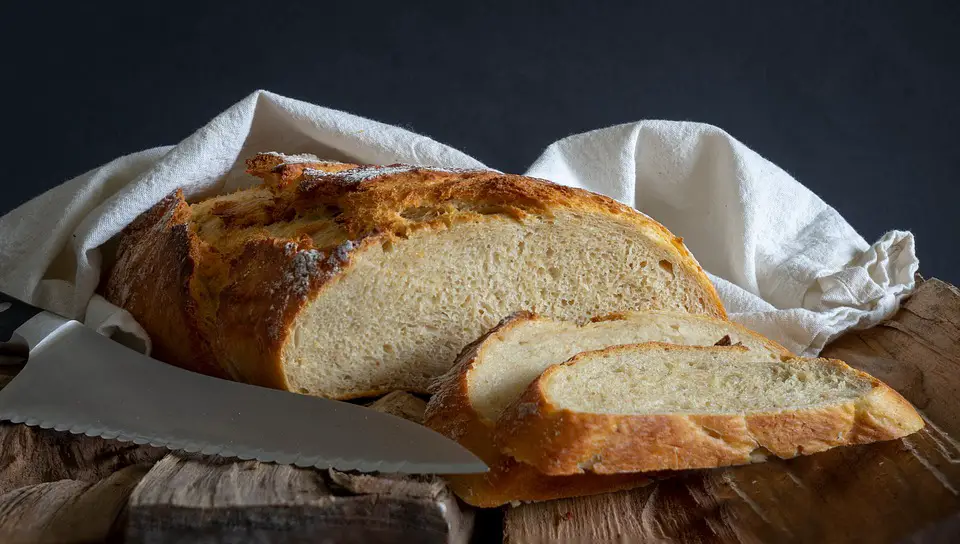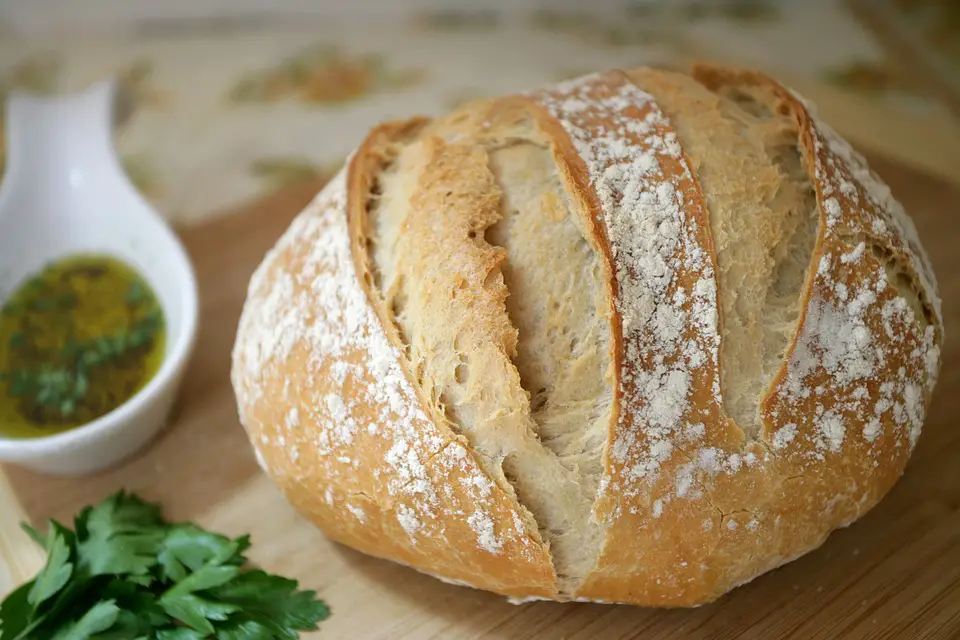Baking bread is a labor of love and knowing how to store homemade bread helps keep it fresher for longer periods.
Homemade bread can be kept in several ways. Utilizing paper bags, a ceramic bread box, and airtight containers are a few of them. Plastic bread boxes are a great alternative to metal bread boxes, which are the most popular and practical. Just make sure to avoid putting it in the refrigerator and choose a container that can keep the bread.

How to Store Homemade Bread?
Homemade bread, from baguettes to sandwich bread, is freshest on the day it is cooked, but you may extend its shelf life by shielding it from warm temperatures and open circulation.
- Wrap it in aluminum foil: Bread is frequently preserved by wrapping it in foil. Use aluminum foil to completely enclose the loaf and shield it from direct air, which leads to staleness. For short-term storage, put the loaf in a bread box or paper bag.
- Bread boxes: Because they are not airtight like resealable bags or containers, bread boxes provide excellent short-term storage options. Bread boxes also referred to as canisters, come in a variety of materials, including plastic, metal, stainless steel, and wood. For added protection against airflow while storing bread in a bread box, wrap the entire loaf in plastic wrap or aluminum foil.
- Food storage container: Because they seal out air, food storage containers can be ideal for storing bread even though their primary use is to store leftovers. However, the size of the airtight container can be a problem if you’re storing several hamburger buns or a large sourdough loaf. Place the final few slices of bread if you have any left.
- A freezer bag offers more insulation from the cold than a regular resealable plastic bag. Because these bags are thicker, frozen food is sufficiently protected and freezer burn is avoided. Slice the bread on a cutting board, then either place the whole loaves in a freezer bag or freeze the slices individually. Slices that have been frozen are easy to reheat, toast, and defrost.
- Resealable plastic bag: By sealing in moisture and keeping out air, a resealable plastic bag keeps your bread tender. If you use this technique, keep the bread at room temperature while keeping an eye out for any extra moisture that could cause mold. Move the bread to another container for long-term storage if water puddles start to form inside the bag.
What are the Different Ideas for Repurposing Old Bread?
Bread begins to go bad as soon as it is taken out of the oven due to starch retrogradation. Even while homemade bread can be kept fresh for several days if stored properly, there are a few uses for the baked goods once they go bad:
- Make your breadcrumbs: Dried bread is ground, crushed, or pulsed into tiny granules to create breadcrumbs, a multipurpose ingredient. Break your stale bread into bits and add them to a food processor or powerful blender to turn them into breadcrumbs. For panko-style breadcrumbs, process or blend the bread until it is coarse, or pulse for a finer texture. Italian spice, salt, and pepper are used to season the breadcrumbs.
- Create a batch of croutons: You may use your stale bread to make homemade croutons if it’s soft enough to cut into cubes. Slice the crusty bread into cubes, add a little salt and olive oil, and bake at 325 degrees Fahrenheit until crisp and golden. Alternatively, you may toast the breadcrumbs without using the oven by stirring them often in a pan over medium heat until they turn golden brown. The croutons can be frozen or kept in a resealable plastic bag.
- Make French toast: French toast is a breakfast and brunch meal made of crusty bread pieces that have been soaked in custard and then fried till crispy and golden. Because French toast is firm enough to keep its shape after being soaked in the custard mixture, which normally contains eggs, milk, sugar, and spices like cinnamon, cardamom, ginger, and nutmeg, it is a fantastic way to use up stale bread.
Is White Bread Made at Home Healthy?
Making your bread involves patience and talent, but the flavor and health advantages are worth the effort. Because of the additives and highly processed flour, it includes, white, packaged bread may not be healthful. Obesity, heart disease, and diabetes have all been related to an excessive intake of white bread. Additionally, compared to bread baked in bakeries, homemade loaves may contain more nutrients and fewer additives. A healthy product is not necessarily guaranteed when buying bread with the term “whole” stated as the first ingredient.
White bread isn’t always bad for you. Even though white bread is highly refined and stripped of many of its natural ingredients, producers are required by FDA laws to add some of these nutrients back in along with others, including iron, folic acid, riboflavin, thiamine, niacin, and occasionally calcium. You might be surprised to learn that processed foods like apple slices, whole-wheat bread, and homemade soup are included. Many processed foods can be found in a balanced diet, while some should be consumed less frequently.
Reference: Willingness to eat bread with health benefits: habits, taste, and health in bread choice
When it comes to products with better health value, particularly when it comes to the nature of the health modification applied in the food product, the relationship between the perceived relevance of taste and health advantages and bread-eating behaviors is still not widely recognized. Modifications to foods are made with these components in mind because many populations must reduce salt intake and enhance fiber intake.
How to Spot a Bad Loaf of Bread?
You should avoid eating stale bread. Not only is it disgusting, but it may also be harmful to your health. The good news is that your bread can be tested using several different methods to see if it has gone bad. Let’s look into it more.
The Mold is Growing on your Bread
Nothing is more disgusting than finding mold on a loaf of bread that was once beautiful. Molded bread shouldn’t be consumed, regardless of color (pink, green, brown, black, or white). It would be beneficial if you didn’t try to discard the moldy slices and save the rest of the batch. It’s unlikely that you will become sick by eating some of the “safe-looking” bread, but you are still consuming mold spores.
As a result, the bread serves as a sponge. Mold spores can spread throughout the bread if they are discovered in one place, while other slices may take longer to develop visibly moldy areas.
Bread with mold is typically identified by its fragrance, and it may have a white, yellow, or black appearance. Although mold is mostly safe, it can be dangerous if eaten or inhaled. Throw away any moldy bread you find right away! Don’t squander your money if the bread has mold on it! Instead, be sure to get fresh, mold-free bread! Before eating, inspect the bread for mold and color to confirm that it is of high quality.
There is a Strange Odor
After all, bread should smell like bread. There isn’t much of a distinctive flavor unless you’re dealing with a loaf of bread that has been flavored with things like raisins, lemon, rosemary, etc. Bread that smells strangely has gone bad and should be thrown away. Poor bread frequently has a vinegary or beer-like aroma that is unrelated to the type of bread you are currently eating. It can also occasionally have an odd and unpleasant odor. If the bread has mold on it, do not smell it. I don’t think many people enjoy the smell of mold, but some people might. However, breathing in mold spores unintentionally can occur when bread smells stale.
What is the Shelf Life of Bread?
Several elements affect how long bread will keep before going bad. The shelf life of bread stored at room temperature is 3–7 days. The specifics depend on the components, bread type, and preservation method. Bread has a limited shelf life, yet it is still important to keep it properly. It should be kept at room temperature for the best results. Bread doesn’t require additional protection if you use it frequently. You can keep it at room temperature as long as the container is still sealed and unopened.
If it’s overlooked, though, something will inevitably go wrong. To prevent this, use bread boxes or plastic storage bags for sliced bread. A traditional method of preserving bread, acidification is also one of the mechanisms used by sourdough to keep baked goods fresh longer. The addition of 1% vinegar to the weight of flour is a natural method for acidifying your dough and, consequently, your bread.
Conclusion
Simply wrap a few slices of bread in a couple of plastic wrap sheets, gently overlapping them to keep air out, if you need to preserve them for a limited period. To avoid freezer burn when freezing bread for long-term storage, wrap it in plastic wrap first, then a layer of aluminum foil. For the subsequent batch of bread, plastic wrap and aluminum foil can both be used.
A bread bag is a canvas, paper, or cloth container used to present and protect a loaf. Loaves can stay fresh in bread bags for the first several days after baking.

